As a constellation, it has to be said that Cancer isn’t one of the most impressive.
Yes, it contains the open cluster M44, also known as the Beehive Cluster (pinpointed by the asterisk in our chart above) and there’s another fainter open cluster near Acubens (Alpha (α) Cancri) called M67, but the stars that form the Zodiacal Crab of Cancer are pretty faint.
Nevertheless, there are still exciting targets to observe in Cancer, including one star that hosts its own planetary system.
Cancer is a northern hemisphere constellation that can be found between Leo and Gemini.
Cancer is also bordered by the constellations Lynx, Leo Minor, Canis Minor and Hydra.
The constellation is known as the Crab in English, and is a great region of the sky to seek out deep-sky objects that can be seen through a telescope.
Read on for our guide to some of the best things to see in Cancer through your telescope.

What to observe in the constellation Cancer
Altarf
The brightest star in Cancer isn’t Acubens as you might think, but Altarf (Beta (β) Cancri) which marks the southwest point of the constellation’s inverted Y-shaped pattern.
The name is from the Arabic ‘Al Tarf’ meaning ‘the End’, and it represents one of the Crab’s legs.
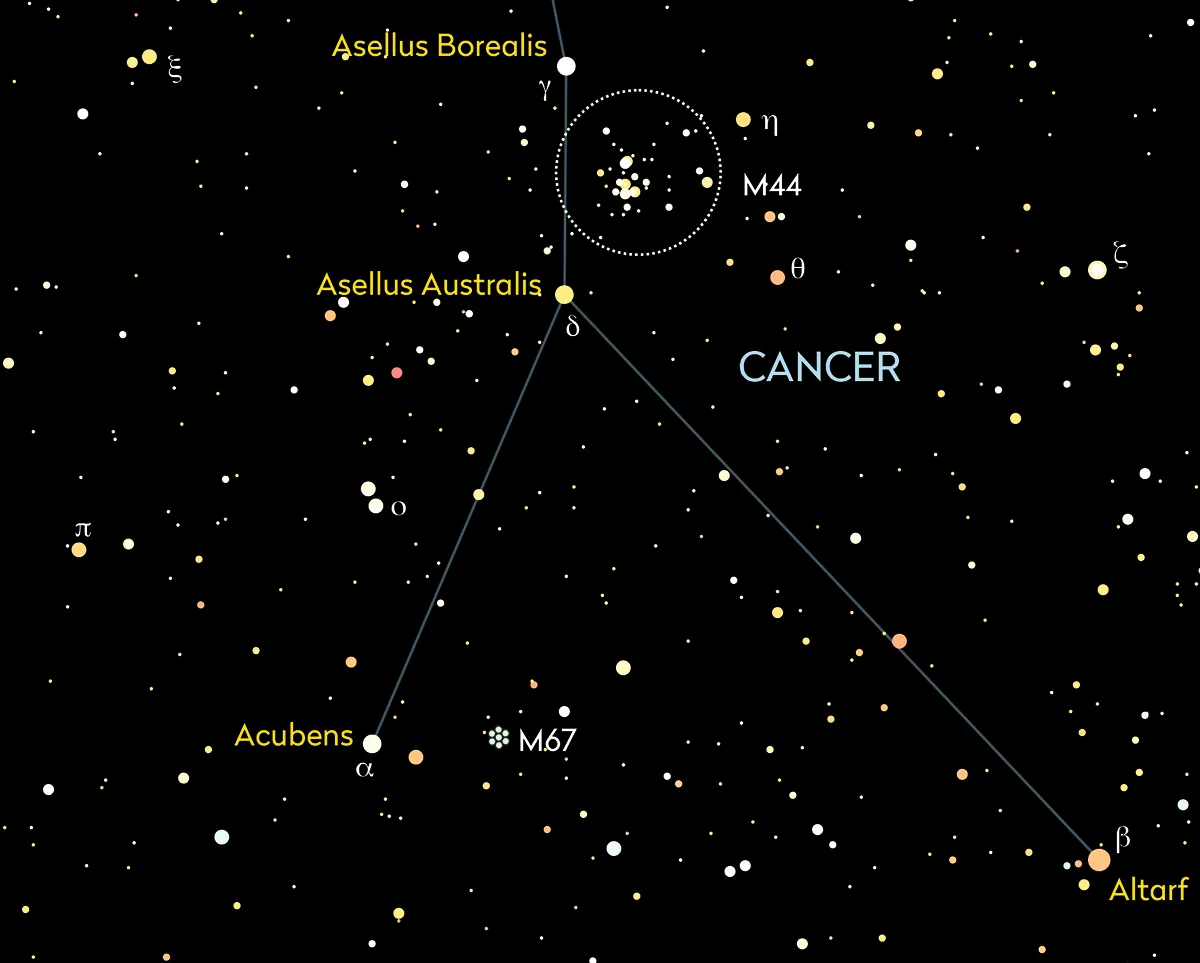
Altarf has a spectral type of K4III Ba1, a cool orange K4 class giant with abundances of barium (chemical symbol Ba).
Its effective temperature is 3,717˚C, which is much cooler than our Sun at 5,505˚C.
Located at a distance of 290 lightyears, Altarf shines at mag. 3.5.
Despite its diminutive status, it should be borne in mind that Altarf is still 61 times larger and 870 times more luminous than the Sun.
A faint red-dwarf companion accompanies the main star. Shining at 14th magnitude, it is estimated
to lie around 2,600 AU from Altarf; that’s around 65 times the Sun-Pluto distance.
The orbital period is estimated to be 76,000 years, but no evidence for any mutual orbital motion has been confirmed yet.
Altarf is also believed to have a planet. Discovered in 2014, this body is estimated to be nearly eight times the mass of Jupiter, orbiting the star once every 605 days at an average distance of 1.7 AU.
55 Cancri
55 Cancri (ρ1 Cancri) is a mag. 5.9 star on the threshold of naked-eye visibility from a typical dark sky site.
The best way to locate it is to first look for mag. 4.0 Iota (ι) Cancri, marking the northern end of the inverted Y-shape of Cancer.
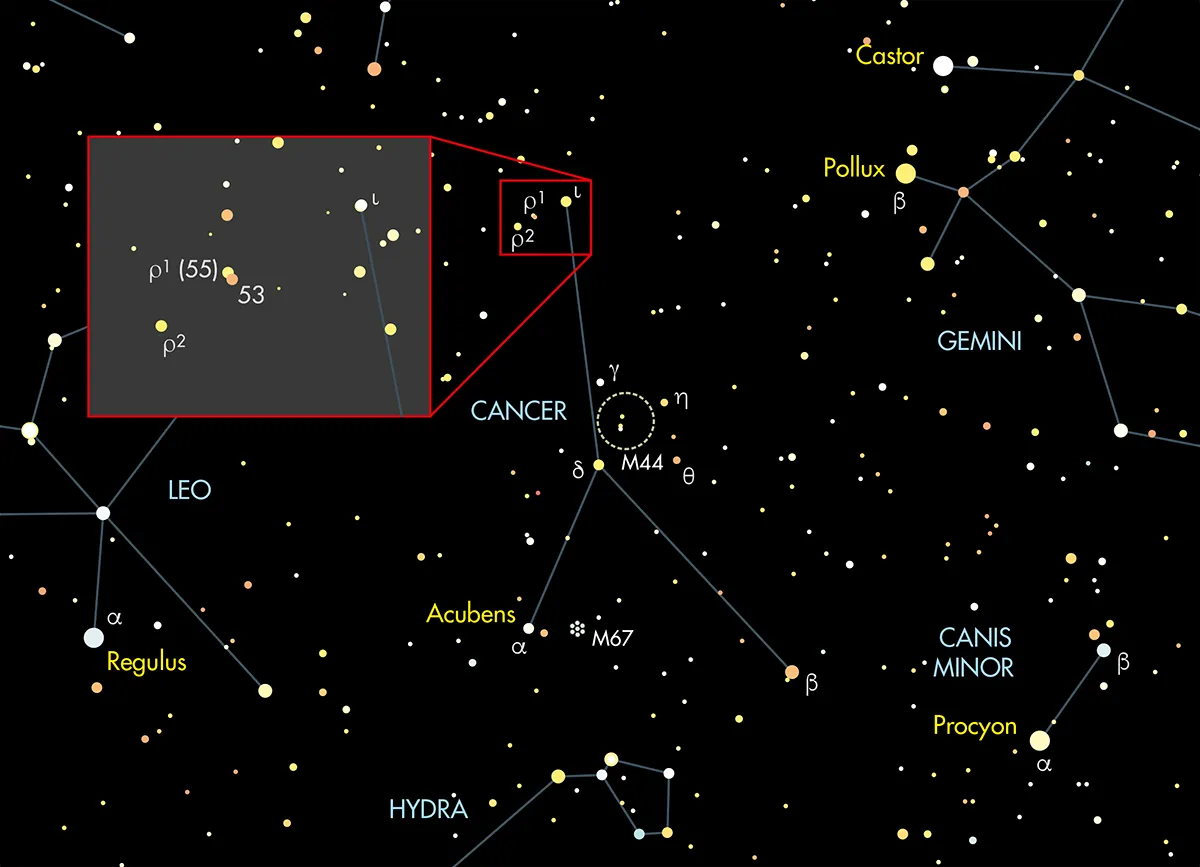
Two degrees west of Iota sits mag. 5.2 ρ2 Cancri, more likely to be seen with the naked eye than ρ1.
Using binoculars, our target star is the northernmost of a close pair of stars located two-thirds of the way from Iota towards ρ2.
This pairing is false as ρ1, at 40.3 lightyears, is just a fraction of the 894 lightyear distance of its ‘pair’, the mag. 6.3 53 Cancri.
55 Cancri is a true binary, consisting of a G-type star, 55 Cancri A, with a 13th magnitude red dwarf companion, 55 Cancri B.

The spectral type of 55 Cancri A is G8V, slightly cooler and redder than the G2V classification of our own Sun.
Physically, there are further similarities as 55 Cancri A has a diameter and mass equal to 96% of the Sun.
Its luminosity is around 59%, with a temperature of 5,165K compared to 5,778K for the Sun.
55 Cancri A’s age is difficult to determine, with estimates ranging between 7.4–12.7 billion years – far older than the Sun’s 4.6 billion years.
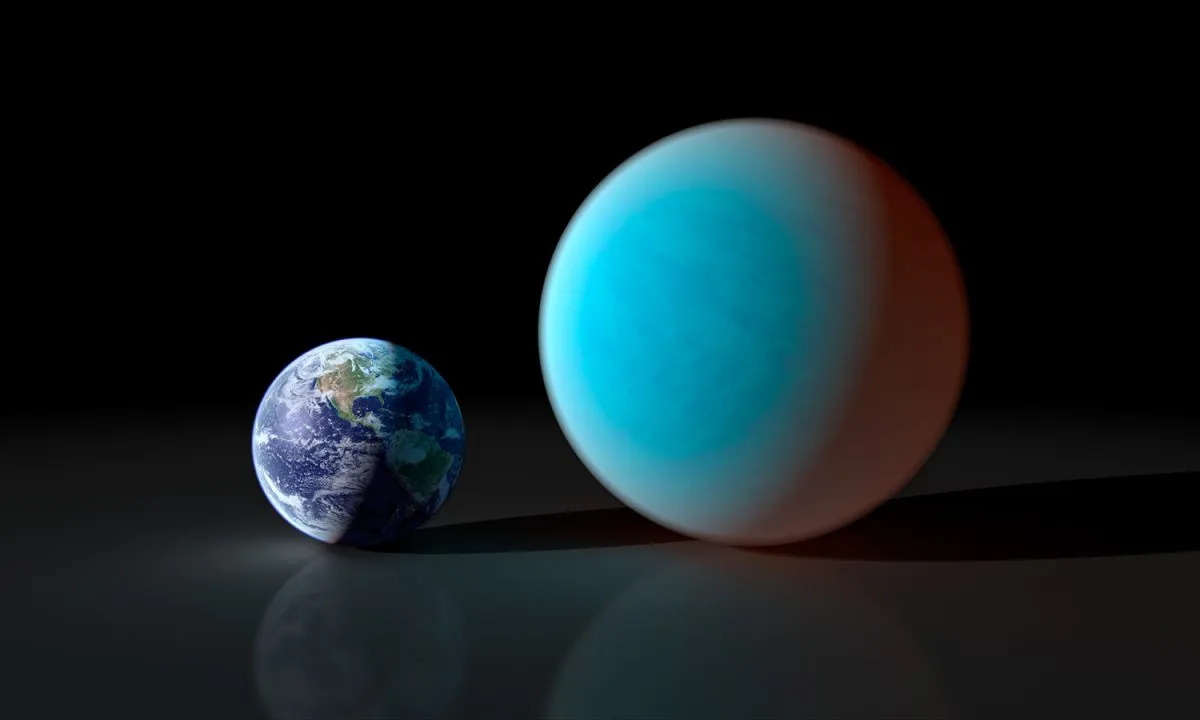
Most excitingly, the star has a planetary system consisting of five or possibly more planets, several within its habitable zone.
Any moons existing around them, if sizeable enough, could play host to simple microbial life.
In 2014 the International Astronomical Union (IAU) asked the public to help name certain exoplanets and their parent stars.
As a result, 55 Cancri A is also known as Copernicus and the five known planets, in order of distance from Copernicus, are Janssen (e), Galileo (b), Brahe (c), Harriot (f) and Lipperhey (d).
A message beamed to the system on 6 July 2003 is set to arrive in May 2044.
6 deep-sky objects in Cancer
Our pick of some of the best deep-sky objects to see in the constellation Cancer.
M44

Our first target needs no introduction. M44, the Beehive Cluster, sits at the heart of Cancer, boxed in by Asellus Borealis (Gamma (γ) Cancri), Asellus Australis (Delta (δ) Cancri), Eta (η) and Theta (θ) Cancri. The cluster is rich, large and visible to the naked eye under dark skies.
With an estimated distance of 594 lightyears, it’s one of the nearest open clusters, appearing 95 arcminutes across. It contains over 200 members, 20 brighter than mag. 8. M44 contains many multiple stars and in excess of 100 variable stars. Most appear towards the yellow-red end of the spectrum, but one stand-out variable star, TX Cancri (mag. 7 to 8) appears blue.
NGC 2672
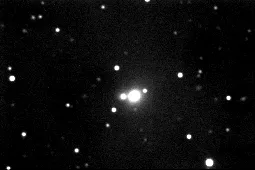
Next is the elliptical galaxy NGC 2672. Wander to the southernmost edge of M44 (near TX Cancri) and look 1.9° to the east. The galaxy lies 0.4° northwest of mag. 6.4 HIP 43427. Discovered on 14 March 1784 by William Herschel, NGC 2672 is just about visible with a 150mm scope under dark skies, but relatively easy to see using a 250mm instrument. It appears circular around 40 arcminutes across, a glow with a tiny, almost stellar nucleus.
There’s a challenge here for larger instruments: seemingly embedded within the east-southeast portion of NGC 2672’s outer halo is galaxy NGC 2673. In terms of brightness, NGC 2672 has an integrated magnitude of 11.6 and NGC 2673 is 12.9.
NGC 2749
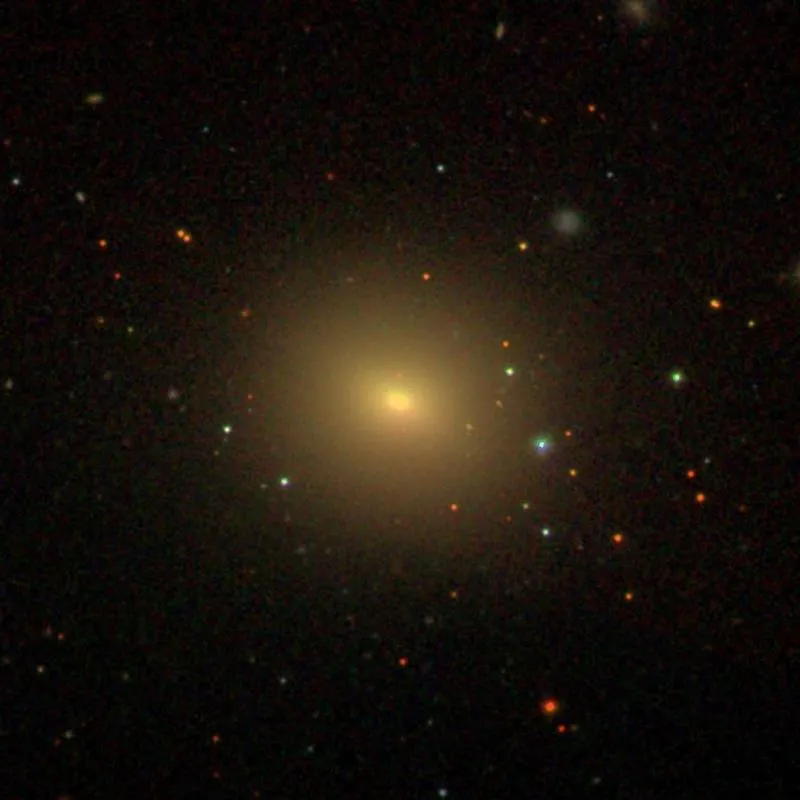
Another elliptical galaxy, mag. 12.0 NGC 2749 is located 3.5° east of HIP 43427 mentioned above. It’s also 3.9° south and a fraction west of mag. 5.2 Xi (ξ) Cancri (not shown). This is a tricky object requiring aperture to see. A 250mm scope shows it as a glow about 1 arcminute in diameter.
The glow appears mostly uniform, but rising to a sharp star-like nucleus. A 300mm scope shows a similar view except the nucleus appears displaced slightly towards the northeast. This is the brightest of a group of galaxies in this region best revealed using long-exposure photography.
Abell 30
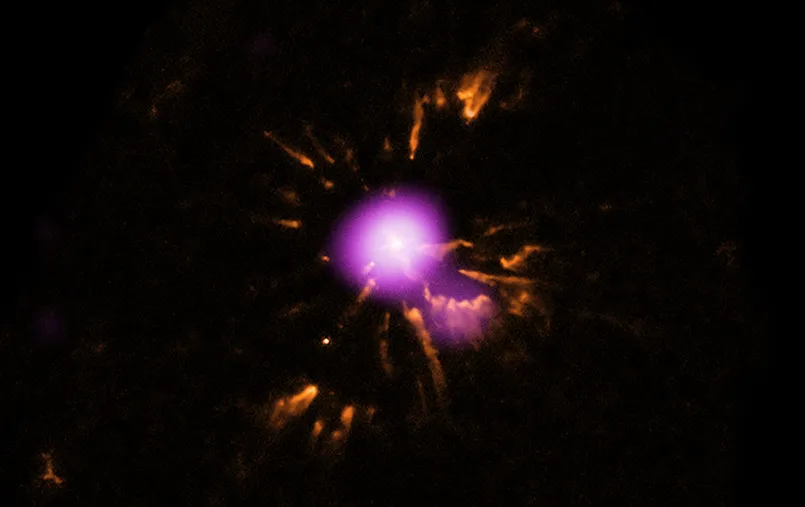
The Abell Catalogue of Planetary Nebulae was compiled in 1966 by George Abell. It consists of 86 largely faint objects, most discovered on photographic survey plates taken with a 1.2m telescope at Mount Palomar. Shining at integrated mag. 13.0 and with a total apparent diameter of 2.1 arcminutes, Abell 30 is a very challenging object. It lies 0.6° east-southeast of Asellus Australis, roughly mid-way between this star and mag. 8.4 TYC 1396-2099-1.
This is best-suited to a large, light-bucket instrument. A 450mm scope should do it, showing a 0.5-arcminute circular glow and dim mag. 14.3 central star. An OIII filter is helpful visually. If you don’t have a large scope, photography is the way to go.
NGC 2648
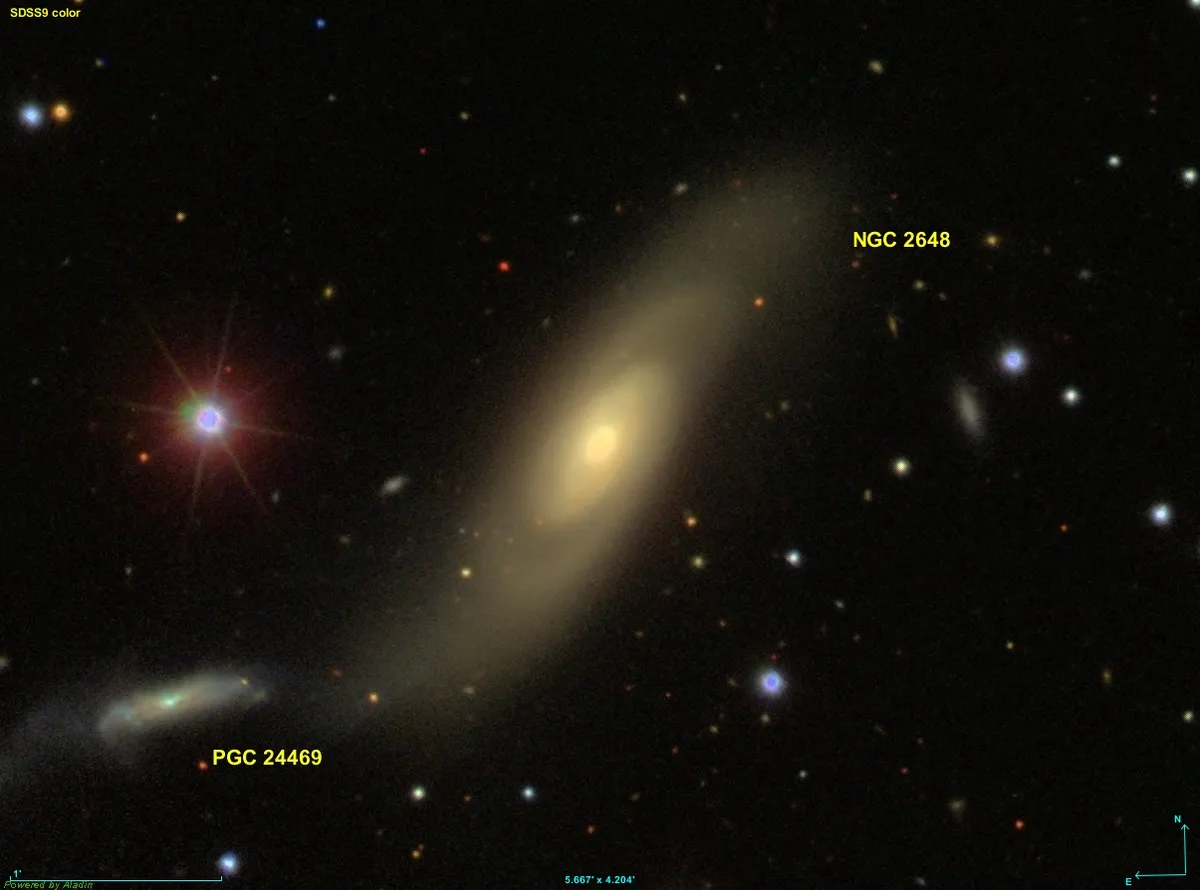
NGC 2648 lies approximately two-thirds of the way from mag. 4.3 Acubens (Alpha (α) Cancri) and mag. 6.3 HIP 42187. It has an apparent magnitude of 11.8, but with a total apparent size of 3.2 x 1.1 arcminutes has low surface brightness. Only the bright core, about 50 arcseconds long, appears visually.
The Palomar Sky Survey plates mentioned above were also used to identify many members of the Arp Atlas of Peculiar Galaxies, galaxies with unusual structures typically generated from active nuclei or gravitational distortions. Many are difficult targets for amateurs. Together with the adjacent mag. 14.6 galaxy PGC 24469, NGC 2648 forms Arp 89.
M67

Overshadowed by its larger and brighter Messier neighbour, M67 is a sixth-magnitude open cluster 2° west of Acubens (Alpha (α) Cancri). With an apparent diameter around 30 arcminutes, through the eyepiece of a telescope M67 appears rich and condensed.
A 150mm instrument reveals around 50 stars brighter than mag. +12 in an area 0.25° across. Around 100 members are visible in a 300mm scope at 120x power. The brightest star in the cluster appears to be HIP 43519 which shines at mag. +7.8, although this is a foreground object estimated to be one-quarter the 2,700-lightyear distance of M67.
This guide originally appeared in the April 2018, March 2022 and April 2023 issues of BBC Sky at Night Magazine.
